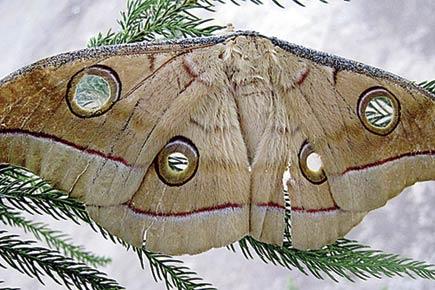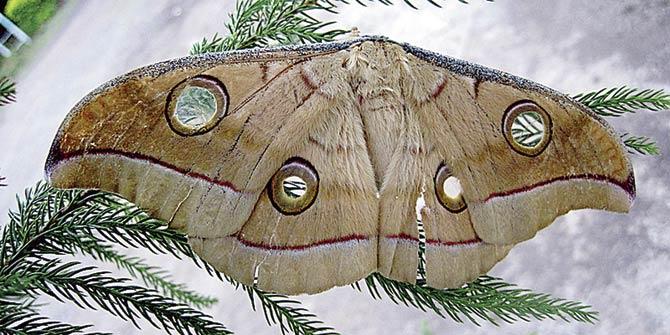Two decades ago, the idea of celebrating a moth week would’ve sounded absurd to me

 Wildlife warden of a metro
Wildlife warden of a metro
Two decades ago, the idea of celebrating a moth week would’ve sounded absurd to me. I would have wondered, why would anybody want to celebrate drab, dull and apparently damaging moths that we so diligently keep away from our clothes with moth balls? But one night of ‘mothing’, changed the perception for good.
ADVERTISEMENT
Mothing or moth-watching is becoming an increasingly popular hobby and area of study, with more information forthcoming from photographers and researchers.

Tussar Silk Moth
Although classified under Order Lepidoptera (meaning ‘scales on wings’), along with butterflies, moths have been meted out step-motherly treatment by scientists and nature-lovers. Maybe their nocturnal and cryptic nature is to blame. You may think them dull, but on closer inspection, one realises that their reflective scaly wings are as colourful as the transparent scaly wings of butterflies.
Moths used to intrigue me during my early days as a wildlife enthusiast. But there was little suitable literature even in leading natural history museums of Mumbai. I had to wait to shift to Dehradun before I could revive my interest in them. During a seven-year stint there (1991-1998), first, as an MSc (Wildlife) student and then as Environment Science (EVS) teacher at a boarding school, I clicked several prints and slides of moths. The massive Entomological Museum at the Forest Research Institute (FRI) was a mind-blowing find. However, with FRI’s focus on wood preservation, moths and their larvae were looked upon as pests rather than an ecologically important group. Nevertheless, I came to understand that the world played home to 10 times more moth species than butterflies, with India itself supporting over 10,000 species.
At FRI, I saw great diversity of moths drab and boring plume and goat moths; multi-coloured hand-maiden moths; the pista green, Moon or Lunar moths with evening gown like wings; fighter plane prototypes or Hawk Moths; the scary Owl moths with eyelet markings on their wings; the note book-size Atlas Moths, the world’s largest.
Much later, I’d receive pictures of Atlas Moths from friends staying in Mulund and Thane. Every visit to Mumbai would turn into a discovery.
A winter night from 2001 is memorable. At a three-day residential, volunteer training workshop at the Sanjay Gandhi National Park (SGNP), one participant ran out screaming from the dormitory bathroom, where a moth was fluttering by the bulb. It was nearly as wide as my palm and had beautiful transparent glass-like oval windows on its creamish orange wings. This was the South Indian small tussore (Antheraea paphia) or a variety of the Tussar Silk Moth. Right then, we decided to set up a moth observation activity. A plain white cloth was tied to two poles spread across six feet, and a bulb placed against it. All other lights in the vicinity were switched off, and as if by magic, within less than 30 minutes, nearly 50 moths collected on the cloth to gather energy from the bulb. Cameras clicked and the participants squealed with amazement. Sadly, we could identify only a few since our guide books were not able to distinguish them.
The Tussar Silk Moth, however, was famous since it has been exploited all over India as a wild source of silk. Most knew that the silk from the cocoons of Tussar Silk Moths was used to make sarees, although the silk emerging from it was rough and had a dull golden sheen. The Tussar silk industry runs into over Rs 100 crore and West Bengal, Chattisgarh, Orissa, Bihar, Madhya Pradesh and Maharashtra contribute to a majority of production. Generally, in cultivated Eri silk, the cocoons are put into boiling water along with larvae. However, the newer Ahimsa Silk, allows the moth to emerge from the cocoon before boiling the short silk fibres to extract the silk, causing no harm to the insect.
In Mumbai, if you live around jamun, ain, arjun or dadam (Terminalia sps), asan, sal or oaks trees, you are likely to be visited by the window-winged moths, bringing with them joy and maybe, a few dozen eggs. So, this week, while the world celebrates Moth Week (July 18-26), look out for the night charmers of the urban forest.
Write in to Anand at sproutsonline@gmail.com
 Subscribe today by clicking the link and stay updated with the latest news!" Click here!
Subscribe today by clicking the link and stay updated with the latest news!" Click here!







